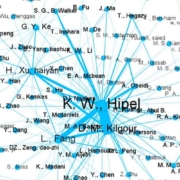Graph Model for Conflict Resolution
The Graph Model for Conflict Resolution (GMCR) is a powerful mathematical tool used to analyze and resolve complex conflicts across various fields, including negotiations, environmental management, and international disputes. Developed in the 1980s, the model has evolved over time, incorporating new techniques and approaches to handle uncertainty and multiple preferences. In this post, you will find a comprehensive and detailed bibliography on GMCR, featuring references from the earliest publications to the most recent ones, organized chronologically for easy reference.
Bibliographic history
Until 1980
- Fraser, N. M., & Hipel, K. W. (1979). “Solving complex conflicts.” IEEE Transactions on Systems, Man, and Cybernetics, 9(12), 805-816.
- Fraser, N. M., & Hipel, K. W. (1980). “Metagame analysis of the Poplar River conflict.” Journal of the Operational Research Society, 31(5), 377-385.
1981 – 1990
- Fraser, N. M., & Hipel, K. W. (1984). Conflict Analysis: Models and Resolutions. North-Holland, New York.
- Kilgour, D. M., Hipel, K. W., & Fang, L. (1987). “The Graph Model for Conflicts.” Automatica, 23(1), 41-55.
- Fang, L., Hipel, K. W., & Kilgour, D. M. (1989). Interactive Decision Making: The Graph Model for Conflict Resolution. Wiley.
1991 – 2000
- Hipel, K. W., Kilgour, D. M., & Fang, L. (1993). “The Graph Model for Conflicts.” Automatica, 29(5), 1425-1437.
- Kilgour, D. M., Hipel, K. W., & Fang, L. (1995). “The Graph Model for Conflict Resolution: Past and Future.” Interfaces, 25(6), 114-133.
- Hipel, K. W., Fang, L., & Kilgour, D. M. (1997). “The Decision Support System GMCR II in Environmental Conflict Management.” Applied Mathematics and Computation, 83(2-3), 117-152.
- Kilgour, D. M., Hipel, K. W., Fang, L., & Peng, X. (1998). “Applying the decision support system GMCR II to peace operations.” In Analysis for and of the Resolution of Conflict. Canadian Peacekeeping Press.
2001 – 2010
- Kilgour, D. M., Fang, L., & Hipel, K. W. (2001). Negotiation in Environmental Conflicts: The Graph Model Approach. Springer.
- Hipel, K. W., Kilgour, D. M., Fang, L., & Peng, X. (2001). “Strategic decision support for the services industry.” IEEE Transactions on Engineering Management, 48(3), 358-369.
- Li, K. W., Hipel, K. W., Kilgour, D. M., & Fang, L. (2004). “Preference uncertainty in the graph model for conflict resolution.” IEEE Transactions on Systems, Man, and Cybernetics, Part A, 34(4), 507-520.
- Li, K. W., Kilgour, D. M., & Hipel, K. W. (2005). “Status quo analysis in the graph model for conflict resolution.” Journal of the Operational Research Society, 56(6), 699-707.
- Obeidi, A., Hipel, K. W., & Kilgour, D. M. (2005). “Perception and emotion in the graph model for conflict resolution.” Proceedings of the 2005 IEEE International Conference on Systems, Man, and Cybernetics.
- Obeidi, A., Kilgour, D. M., & Hipel, K. W. (2009). “Perceptual stability analysis of a graph model for conflict resolution.” Group Decision and Negotiation, 18(3), 261-277.
- Peng, X., Hipel, K. W., Kilgour, D. M., & Fang, L. (2008). “A Graph Model for Conflict Resolution with Recursive Preferences.” Group Decision and Negotiation, 17(6), 491-513.
2011 – 2024
- He, S., Kilgour, D. M., & Hipel, K. W. (2017). “Analyzing market competition between Airbus and Boeing using a duo hierarchical model for conflict resolution.” Journal of Systems Science and Systems Engineering, 26(6), 683-710.
- Xu, H., Hipel, K. W., Kilgour, D. M., & Fang, L. (2015). “A Multiple Participant–Multiple Criteria Decision-Making Model Based on the Graph Model for Conflict Resolution.” Journal of Systems Science and Systems Engineering, 24(2), 188-210.
- Fang, L., Hipel, K. W., Kilgour, D. M., & Peng, X. (2013). “A Decision Support System for Interactive Decision Making, Part II: Analysis and Application.” IEEE Transactions on Systems, Man, and Cybernetics: Systems, 43(2), 185-197.
- Li, Y., Hipel, K. W., Kilgour, D. M., & Fang, L. (2016). “Preference Elicitation in the Graph Model for Conflict Resolution.” European Journal of Operational Research, 252(1), 352-363.
- Fang, L., Hipel, K. W., Kilgour, D. M., & Wang, L. (2020). “Uncertainty Modeling in the Graph Model for Conflict Resolution.” IEEE Transactions on Systems, Man, and Cybernetics: Systems, 50(1), 82-92.
- Wang, L., Hipel, K. W., Kilgour, D. M., & Fang, L. (2021). “Strategic Analysis of Conflicts with Incomplete Information Using the Graph Model.” IEEE Transactions on Systems, Man, and Cybernetics: Systems, 51(5), 2940-2952.
- Xu, H., Kilgour, D. M., & Hipel, K. W. (2018). “An Algorithm for Multiple Criteria Status Quo Analysis in the Graph Model for Conflict Resolution.” European Journal of Operational Research, 271(2), 720-731.
- Fang, L., Hipel, K. W., & Kilgour, D. M. (2019). “Analysis of Multilateral Conflicts with Strategic Uncertainty.” Group Decision and Negotiation, 28(3), 573-591.
- Sabino, E. R., & Rêgo, L. C. (2024). “Minimax regret stability in the graph model for conflict resolution.” European Journal of Operational Research, 314(3), 1087-1097.
Deoclécio Paiva de Castro
Ph.D student in Economics
M.Sc in Mathematical Optimization Modeling and Quantitative Methods
B.Sc in Industrial/Production Engineer

